Solomon King
Comments for Study 1
Pick to read this Bible passage in a separate window.
MAPS OF ISRAEL AND JUDAH
MAP OF THE DIVISION OF CANAAN
MAP OF DAVID'S ESCAPE FROM SAUL AND BATTLE AT GILBOA
MAP OF DAVID'S CONQUESTS
MAP OF THE UNITED KINGDOM OF ISRAEL
MAP OF JERUSALEM AND THE TEMPLE
LIST OF ISRAEL'S KINGS AND PROPHETS
TIMELINE OF ISRAEL'S HISTORY
I. Solomon Asks for Wisdom (1:1-17)
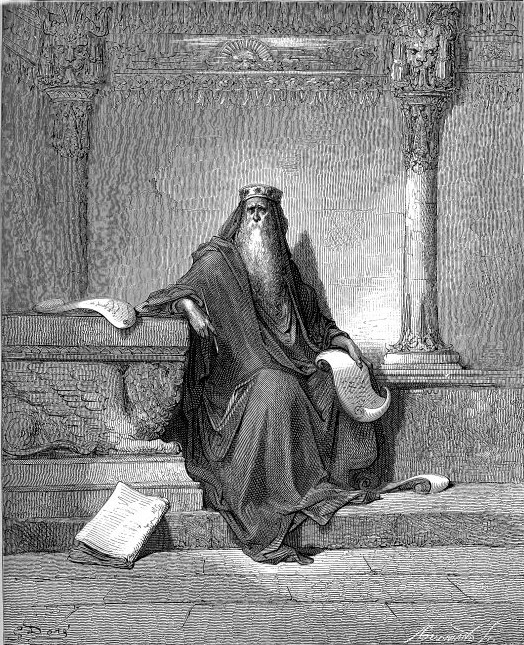
* See a wood engraving by Gustave Dore (1832-1883) to the right depicting King Solomon. Dore's drawings were in Bibles that are now in public domain. This one was scanned in by creationism.org.
>1. What was the source of Solomon's wisdom? How did his wisdom compare with other wisdom?
* "Solomon son of David established himself firmly over his kingdom, for the LORD his God was with him and made him exceedingly great.
2 Then Solomon spoke to all Israel--to the commanders of thousands and commanders of hundreds, to the judges and to all the leaders in Israel, the heads of families--
3 and Solomon and the whole assembly went to the high place at Gibeon, for God's Tent of Meeting was there, which Moses the LORD's servant had made in the desert.
4 Now David had brought up the ark of God from Kiriath Jearim to the place he had prepared for it, because he had pitched a tent for it in Jerusalem.
5 But the bronze altar that Bezalel son of Uri, the son of Hur, had made was in Gibeon in front of the tabernacle of the LORD; so Solomon and the assembly inquired of him there.
6 Solomon went up to the bronze altar before the LORD in the Tent of Meeting and offered a thousand burnt offerings on it." (1-6)
* 1 Kings 3:2-28 also records Solomon's wisdom was a gift of God. That passage does not go into as much depth as 2 Chronicles 1.
* "high place at Gibeon" -The tent of meeting was located in Gibeon (a mountain) from the time of Joshua until the temple was built in Jerusalem. Gibeon was a city of that dates back to before the time of Abraham.
* Many Israelites had religious inclination. Some had a pure love for God. David did and now Solomon did. The ark of the Lord which contained the covenant etched in stone and manna was in Jerusalem. However, the tabernacle, that is the tent of meeting was still on mount Gilead. When anyone wanted to worship and inquire of the Lord they would have to go to there.
Solomon was an adolescent. He had many older brothers who were jealously plotting to overthrow Solomon. The Israelites were many, powerful, well educated, and wealthy like never before. Solomon was intimidated by the thought of leadership. He accepted his father's advice and went to seek the Lord.
Life always seems to have circumstances that are challenging and/or intimidating. Just when things are going in a good way, a new problem comes.
Whether in want or in plenty seek the Lord. The Israelites would go to mount Gilead. Where do I go now?
Jesus was the Lord at mount Gilead. Jesus was in the tabernacle. Jesus is my mount Gilead.
*
*
>2. What are some of the gifts Jesus gives to his people? (1 Cor. 12:8-11) Why does he give us these gifts? (1 Cor. 12:7)
* "That night God appeared to Solomon and said to him, "Ask for whatever you want me to give you."
8 Solomon answered God, "You have shown great kindness to David my father and have made me king in his place.
9 Now, LORD God, let your promise to my father David be confirmed, for you have made me king over a people who are as numerous as the dust of the earth.
10 Give me wisdom and knowledge, that I may lead this people, for who is able to govern this great people of yours?" (7-10)
* 1 Corinthians 12:8-11 "To one there is given through the Spirit the message of wisdom, to another the message of knowledge by means of the same Spirit, to another faith by the same Spirit, to another gifts of healing by that one Spirit, to another miraculous powers, to another prophecy, to another distinguishing between spirits, to another speaking in different kinds of tongues, and to still another the interpretation of tongues. All these are the work of one and the same Spirit, and he gives them to each one, just as he determines."
* What is it I want? If I were in Solomon's place and the Lord God were to say to me, "Ask for whatever you want me to give you," what would I say?
Yet, I am not like Solomon. I am not young. I am not starting out in a new career. I am not king of the regional power. I do not have enemy kingdoms on my boarders. I do not have siblings who want to take the throne. I do not have a family to start, a royal line to preserve.
Yet in my place what would I ask for? What do I ask in prayer? What do I want and what do I need? Is there a poor response?
The Lord's reply to Solomon's request for wisdom to rule Israel reveals that there is one request that is better than others. Do I have but one request? I can pray anytime and anywhere.
Jesus taught, "Seek first my kingdom and righteousness and all these will be given."
*
*
*
*
>3. What did God say about Solomon's request for wisdom? What can be learned about God?
* "God said to Solomon, "Since this is your heart's desire and you have not asked for wealth, riches or honor, nor for the death of your enemies, and since you have not asked for a long life but for wisdom and knowledge to govern my people over whom I have made you king,
12 therefore wisdom and knowledge will be given you. And I will also give you wealth, riches and honor, such as no king who was before you ever had and none after you will have."
13 Then Solomon went to Jerusalem from the high place at Gibeon, from before the Tent of Meeting. And he reigned over Israel." (11-13)
* Matthew 6:33 "But seek first his kingdom and his righteousness, and all these things will be given to you as well."
*
*
*
*
>4. Did God keep his promise? To what extent?
* "Solomon accumulated chariots and horses; he had fourteen hundred chariots and twelve thousand horses, which he kept in the chariot cities and also with him in Jerusalem.
15 The king made silver and gold as common in Jerusalem as stones, and cedar as plentiful as sycamore-fig trees in the foothills.
16 Solomon's horses were imported from Egypt and from Kue--the royal merchants purchased them from Kue.
17 They imported a chariot from Egypt for six hundred shekels of silver, and a horse for a hundred and fifty. They also exported them to all the kings of the Hittites and of the Arameans." (14-17)
* 1 Kings 4:20-27 records Solomon's daily provisions.
* The Lord God enabled Solomon to be extremely wealthy and prosperous. Horses and chariots were a measure of extravagance in those days. Solomon had many of both (14). He also made silver, cedar, and gold common (15). Thus his wealth flowed to the people of Israel through commerce.
Before this shower of wealth and status were all the battles won by his father. God, through David who was after the Lord's heart, enabled Solomon to have peace. This in turn provided a stable growing economy. All this was arranged by the Lord God as he had promised David.
What did Solomon and Israel do with the environment provided and arranged by the Lord? Tjey did not do what the Lord wanted. They did not advance and share the wisdom and knowledge of the Lord with the nations. Instead of helping outward the rusted and corroded inward.
I am not envious of Solomon and his wealth. The Chronicler(s) does not mention Solomon's eventual path into selfish sinful endeavors that is common among the wealthy. That is recorded elsewhere.
Finally, after seeking self centered pleasures and sin, in his later life book Ecclesiastes Solomon wrote, "Meaningless, meaningless, utterly meaningless." Solomon was not happy in his wealth and sin (Eccl. 2:1, 6:2, 12:1).
*
*
II. Solomon Prepares to Build the Temple (2:1-18)

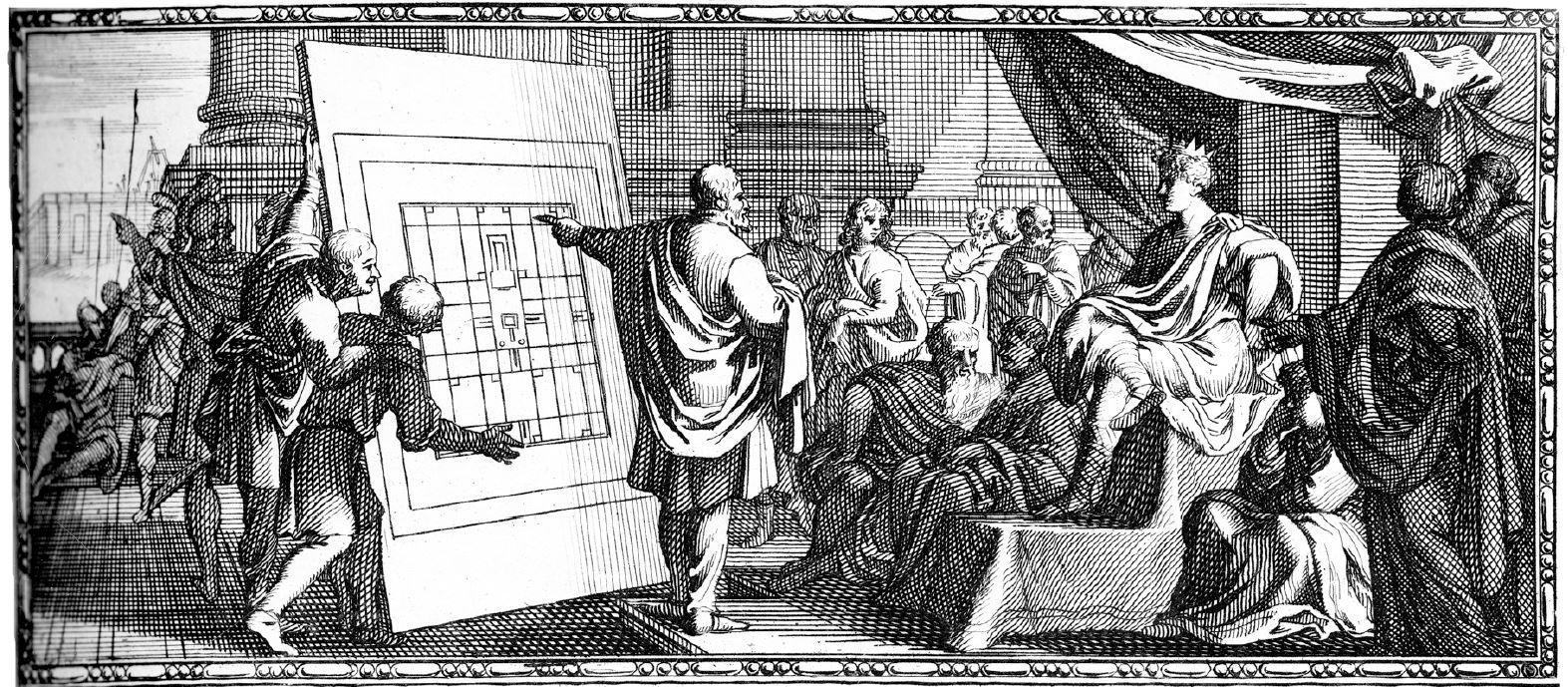
* See a drawing by Willem Goeree (1635-1711) to the right depicting King Solomon beginning the plans to build the temple. Courtesy of the Digital Image Archive, Pitts Theology Library, Candler School of Theology, Emory University: http://www.pitts.emory.edu.
>5. What did Solomon tell Hiram king of Tyre? What can we learn about Solomon's heart at this time of his reign?
* "Solomon gave orders to build a temple for the Name of the LORD and a royal palace for himself.
2 He conscripted seventy thousand men as carriers and eighty thousand as stonecutters in the hills and thirty-six hundred as foremen over them.
3 Solomon sent this message to Hiram king of Tyre: "Send me cedar logs as you did for my father David when you sent him cedar to build a palace to live in.
4 Now I am about to build a temple for the Name of the LORD my God and to dedicate it to him for burning fragrant incense before him, for setting out the consecrated bread regularly, and for making burnt offerings every morning and evening and on Sabbaths and New Moons and at the appointed feasts of the LORD our God. This is a lasting ordinance for Israel.
5 "The temple I am going to build will be great, because our God is greater than all other gods.
6 But who is able to build a temple for him, since the heavens, even the highest heavens, cannot contain him? Who then am I to build a temple for him, except as a place to burn sacrifices before him?
7 "Send me, therefore, a man skilled to work in gold and silver, bronze and iron, and in purple, crimson and blue yarn, and experienced in the art of engraving, to work in Judah and Jerusalem with my skilled craftsmen, whom my father David provided.
8 "Send me also cedar, pine and algum logs from Lebanon, for I know that your men are skilled in cutting timber there. My men will work with yours
9 to provide me with plenty of lumber, because the temple I build must be large and magnificent.
10 I will give your servants, the woodsmen who cut the timber, twenty thousand cors of ground wheat, twenty thousand cors of barley, twenty thousand baths of wine and twenty thousand baths of olive oil." (1-10)
* 1 Kings 5 also records the exchange between Solomon and Hiram king of Tyre.
* Solomon announced his continuing commitment to build a magnificent temple to the Lord God of Israel as his father David had instructed him and had started (1). He also announced his plans to build a large palace as his father had done (1).
Solomon needed large cedar logs to build these buildings, a resource that Israel did not have. He sent a message to Hiram king of Tyre stating his desire to aquire cedar from the vast forest on mount Lebanon (3,8).
Solomon's request contained the confession, "But who is able to build a temple for him, since the heavens, even the highest heavens, cannot contain him? Who then am I to build a temple for him, except as a place to burn sacrifices before him? (6)" The words "contain him" is in most English translations of the Bible. Simply put Solomon's God inspired wisdom was stating the truth that even the heavens are too small a place for the Lord God to live in.
Some may state that this is evidence that God's Spirit cannot dwell in a human let alone in the person of Jesus Christ. However, Solomon continued his confession, "...except as a place to make offerings." The temple was never meant nor contain nor imprison all of the essence God. It was made for humans to present offerings and inquire of the Lord just as God instructed Moses.
Similar to this, Jesus who is God in the flesh is the exact representative of God so that humans may physically interact with God. So was the case of the Lord God with Adam and Eve who "walked with the Lord God in the cool of the evening. " So was the case of one of the three visitors to Abraham. So was the case with Jacob who wrestled with God one night. So is it with Job and the wirl-wild, Moses in the cleft of the rock, all the prophets and many more.
Now the Spirit of Jesus is in me, not that all of God is contained in me. Rather, all that is God is part of my being. God is always accessible to me and always always accessing me.
* The payment here differs from that reported in 1 Kings 5:11, but the texts speak of two different payments: In Kings the payment is an annual sum delivered to the royal household of Hiram, while Chronicles speaks of one payment to the woodsmen. The goods paid are also not identical; the oil specified in Kings is of a finer quality.
*
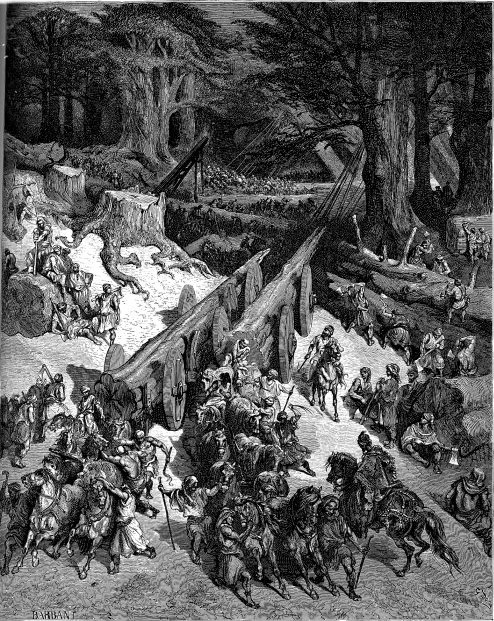
* See a wood engraving by Gustave Dore (1832-1883) to the right depicting the cutting down of cedars for the construction of the temple. Dore's drawings were in Bibles that are now in public domain. This one was scanned in by creationism.org.
>6. How did Solomon's message affect Hiram? (7) What was his reply to Solomon?
* 2 Chronicles 2:11-16 "Hiram king of Tyre replied by letter to Solomon: "Because the LORD loves his people, he has made you their king."
12 And Hiram added: "Praise be to the LORD, the God of Israel, who made heaven and earth! He has given King David a wise son, endowed with intelligence and discernment, who will build a temple for the LORD and a palace for himself.
13 "I am sending you Huram-Abi, a man of great skill,
14 whose mother was from Dan and whose father was from Tyre. He is trained to work in gold and silver, bronze and iron, stone and wood, and with purple and blue and crimson yarn and fine linen. He is experienced in all kinds of engraving and can execute any design given to him. He will work with your craftsmen and with those of my lord, David your father.
15 "Now let my lord send his servants the wheat and barley and the olive oil and wine he promised,
16 and we will cut all the logs from Lebanon that you need and will float them in rafts by sea down to Joppa. You can then take them up to Jerusalem." (11-16)
* Hiram, king of Tyre was pleased with Solomon's request so much so that he praised the Lord, the God of Israel (11,12). Tyre's chief deity was Melqart, also spelled Melkart or Melkarth, the Phoenician god. He was also called the Tyrian Baal.
Hiram didn't say that the Lord was his God. So he wasn't converted from his pagan deities and idol worship to Judaism. He was only glad that Solomon was wise and friendly with Tyre, acknowledging the existence of Solomon's God, the Lord.
Many reasons exist why people seek some form of religion. Many came to Jesus when He walked the earth for many reasons. The same is today. I am not their judge, I only acknowledge that others are different than me. Some will be like Hiram acknowledging Jesus while holding onto superstition and pagan beliefs.
How about me? Why do I confess the name of the Lord Jesus? Am I happy and joyful merely because something good has come my way? Or does my faith in Jesus have root in wanting more than just a casual relationship with him? Is my passion for him hot or lukewarm?
Jesus said many are called but few follow. He told the apostles after all left him after feeding the 5,000, "Are you not the twelve I have chosen?" meaning they remain because he chose them. I remain only because of the grace and mercy of Jesus. I exist in Christ with faith, hope, and love. Only these three remain in the end.
* "Hiram king of Tyre" -Hiram ruled over Tyre from rouffly 978 to 944 B.C. He may have also served as co-regent with his father Abibaal as early as 903 B.C. Before Solomon was born, Hiram provided timber and workmen for the building of David's palace (2 Sammuel :11)
* The books of Kings states Solomon's request for a master craftsman late in the narrative (1 Kings 7:13). To carry out the parallel between Oholiab and Huram-Abi, the Chronicler(s) includes it in the initial correspondance. Furthermore, in 2 Chronicles 2:7, 13-14 the list of Huram-Abi's skills is expanded and matches that of Bezalel and Oholiab. (Kings is concerned only with casting bronze.)
*
>7. Being that the Israelites were not lumberjacks, how was Solomon's wisdom used to get wood for the temple? (1 Kings 5:10-12) How many men were needed? (13-16) Why would a foundation be needed for the temple? (17-18, 2 Chron. 3:1-4, Kings 5:17-18) Is that foundation still there today?
* "Solomon took a census of all the aliens who were in Israel, after the census his father David had taken; and they were found to be 153,600.
18 He assigned 70,000 of them to be carriers and 80,000 to be stonecutters in the hills, with 3,600 foremen over them to keep the people working." (17-18)
* "all the aliens who were in Isreal" -1 Kings 5:13-16 states the workforce included "conscripted laborers from all Israel". Resentment among the people toward this sort of forced labor eventually led to a civil uprising and the division of Solomon's kingdom immediately after his death. (1 Kings 9:15, 12:1-18; 2 Samuel 20:24)
The Chronicler(s) specifies that this levy of forced laborers was from aliens resident in the land, not neccissarily including Israelites. This is not stated in the parallel passage in Kings, though 1 Kings 9:20-22 confirms that alien labor was used.
* "3,600 foremen" -The number given in 1 Kings 5:16 is 3,300. However, some manuscripts of the Septuagint (the Greek translation of the OT) also have 3,600. The Chronicler(s) may have been following a differnt text of Kings from the present Masoretic (traditional Hebrew) text at this point. It is also probable that during the extensive time of building the temple to amount of foremen varied just as current massive labor forces of large companies constatly change for many reasons.
*
*
*
III. Solomon Builds the Temple (3:1-4:22)

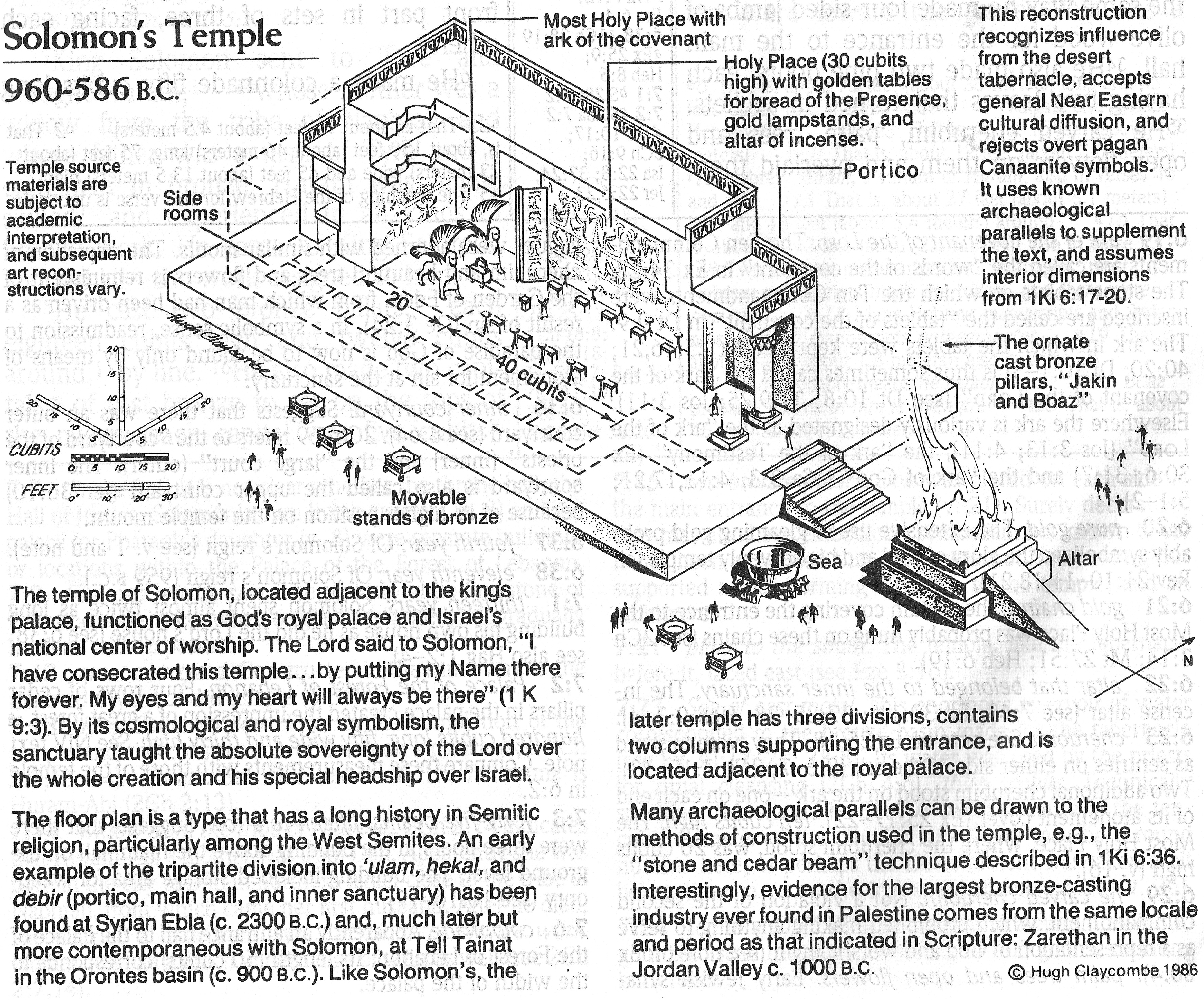
* See drawing of Solomon's temple to the right from the NIV Study Bible by Hugh Claycombe (copyright 1986) no longer in print. Temple source materials are subject to academic interpretation, and subsequent art reconstructions wary. Use the link above to see further renderings of Jerusalem and the temple mount.
>8. Why is the exact timing of the beginning of the work important? (1) Draw a proportional sketch of the temple as described in verses 3-4. Why make the blocks as described in these verses?
* 2 Chronicles 3:1-7 "Then Solomon began to build the temple of the LORD in Jerusalem on Mount Moriah, where the LORD had appeared to his father David. It was on the threshing floor of Araunah the Jebusite, the place provided by David.
2 He began building on the second day of the second month in the fourth year of his reign.
3 The foundation Solomon laid for building the temple of God was sixty cubits long and twenty cubits wide (using the cubit of the old standard).
4 The portico at the front of the temple was twenty cubits long across the width of the building and twenty cubits high. He overlaid the inside with pure gold.
5 He paneled the main hall with pine and covered it with fine gold and decorated it with palm tree and chain designs.
6 He adorned the temple with precious stones. And the gold he used was gold of Parvaim.
7 He overlaid the ceiling beams, doorframes, walls and doors of the temple with gold, and he carved cherubim on the walls." (1-7)
* 1 Kings 6 also record Solomon building the temple.
* "Then Solomon began to build the temple of the LORD in Jerusalem on Mount Moriah" -The temple was patterned after the tabernacle (and, in general, other temples of the time) and was divided into three major areas; the Most Holy Place, the Holy Place and the outer courtyard. The Most Holy Place in the temple was cubical, as it probably was in the tabernacle. The dimensions of the temple in most instances seem to be double those of the tabernacle (Exodus 26:15-30, 36:20-34).
* "Mount Moriah" -This is the only passage in the Old Testament where Mount Zion is identified with Mount Moriah, the place where Abraham was commanded to offer Isaac (Gen. 22:2, 14).
* "place provided by David" -The event that lead to David purchasing this land in recorded in 1 Chronicles 21:18-22:1.
* "on the second day of the second month in the fourth year of his reign" -The building of the temple was in the spring of 966 B.C. 1 Kings 6:1 adds the amount of years this was since the exodus out of Egypt, 480 years.
* The temple was built on Mount Moriah (aka Mount Zion) starting in the spring of 966 B.C. The Lord had appeared to David on this mountain (1). The meeting was not a pleasant one. 70,000 men died of a plague and the Lord had sent an angel to destroy Jerusalem (1 Chron. 21) because David had counted the fighting men.
The angel (who is identified as the LORD here) had paused before he continued into the city. His pause was long enough for David and the city officials to go to the place. I imagine that the LORD had paused because he was hovering over the place where Abraham almost offered his son Isaac many centuries earlier (Gen. 22). The Lord remembered Abraham's faith, hope, and love for him and so did David and city officials.
God does not forget his people's faith, hope, and love. They are the greatest gifts, the only gifts we can give to him. The impact lasts for generations in ways I cannot even begin to imagine. The world believes these acts are nothing. Even I wonder, "Will a descendant of mine know how important my faith in Jesus has been? Will they also have the same faith?" The LORD Jesus knows.
* The Chronicler(s) has considerably curtailed the description of the temple's construction found in Kings chapters 6 and 7, omitting completely 1 Kings 6:4-20. This abridgment probably indicates that the Chromiclers' audience was familiar with the details of the earlier history and that the temple of the restoration period was less elaborate than the original Solomonic structure (Hag. 2:3). On the other hand, the Chronicler(s) goes into more detail on the furnishings and implements (3:6-9; 4:1, 6-9).
* "overlaid" -See note in the question below.
* "Parvaim" -Designates either the source of the gold (perhaps southeast Arabia) or a particular quality of fine gold.
>9. What did the interior look like? (8-17) What was the ark of the covenant? (Exodus 25:22; and 1 Chron. 28:2) With all the gold in the inner sanctuary, what would happen if a light would be in there? (Exodus 24:15-17) How does this relate to what we are told about Jesus? (Matt. 17:1-2; John 1:3-14; and 2 Cor. 4:6; Rev. 21:23)
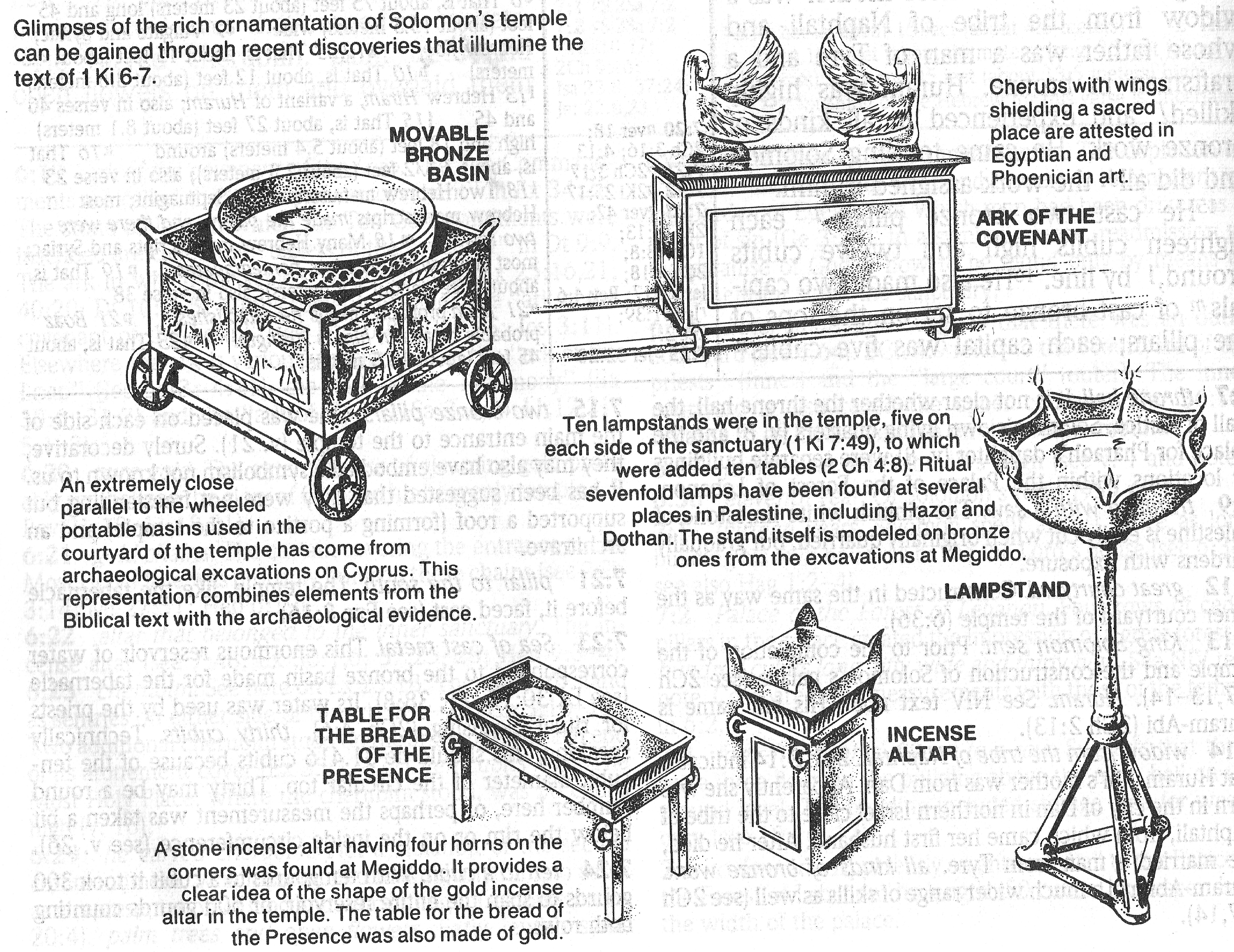
* See drawings of the temple furnishings to the right from the NIV Study Bible. Glimpses of the rich ornamentation of Solomon's temple can be gained through recent discoveries that illumine the text of 1 Kings 6-7 and 2 Chronicles 1-4.
* 2 Chronicles 3:8-17 "He built the Most Holy Place, its length corresponding to the width of the temple--twenty cubits long and twenty cubits wide. He overlaid the inside with six hundred talents of fine gold.
9 The gold nails weighed fifty shekels. He also overlaid the upper parts with gold.
10 In the Most Holy Place he made a pair of sculptured cherubim and overlaid them with gold.
11 The total wingspan of the cherubim was twenty cubits. One wing of the first cherub was five cubits long and touched the temple wall, while its other wing, also five cubits long, touched the wing of the other cherub.
12 Similarly one wing of the second cherub was five cubits long and touched the other temple wall, and its other wing, also five cubits long, touched the wing of the first cherub.
13 The wings of these cherubim extended twenty cubits. They stood on their feet, facing the main hall.
14 He made the curtain of blue, purple and crimson yarn and fine linen, with cherubim worked into it.
15 In the front of the temple he made two pillars, which [together] were thirty-five cubits long, each with a capital on top measuring five cubits.
16 He made interwoven chains and put them on top of the pillars. He also made a hundred pomegranates and attached them to the chains.
17 He erected the pillars in the front of the temple, one to the south and one to the north. The one to the south he named Jakin and the one to the north Boaz." (8-17)
* "Most Holy Place" -The same terminology was used for the inner sancturary house the Ark in the tabernacle (Exodus 26:33-34; Lev. 16:2, 16-17, 20, 23).
* "overlaid the inside with six hundred talents of fine gold" -"Overlaid" in the orginal Hebrew is "sapa." Sapa is translated lined, overlay, covered, or garnished. Some say the intent here is "inlaid," which would give a more correct picture with 1 Kings 6:14-18: not that the entire interior was covered with gold leaf, but that designs (palm trees, chains) were inlaid with gold leaf (5).
* "twenty cubits long and twenty cubits wide." -It was also 20 cubits high (1 Kings 6:20), making the dimensions of the Most Holy Place a perfect cube, as probably also in the tabernacle. In the New Jerusalem there is no temple (Rev. 21:22); rather, the whole city is in the shape of a cube (Rev. 21:16), for the whole city become "the Most Holy Place".
* The inside of the temple was filled with glistening polished gold. Even a small amount of light would reflect brightly. The finest materials were crafted into precise finely decorated usable shapes. All were made to represent the Lord God's throne in heaven. The magnificent temple was a place where people could present themselves to the invisible, powerful, glorious maker of the universe.
My soul is now the temple of God. The Spirit of God dwells in my being. I am to submit to God so my life, my being, my character, my heart, and my mind are to be an acceptable place for God to dwell. The attention to every detail is to be God's exacting standard. I am a living stone being built into a spiritual house to be a holy priest, offering spiritual sacrifices acceptable to God through Jesus Christ. (1 Peter 2:5)
My purifying would not be possible without Jesus' sacrifice for me. Jesus' death makes me acceptable to God. In view of God's mercy, I submit my body as a living sacrifice holy, pleasing, and acceptable to God as my spiritual act of worship. (Romans 12:1)
* 1 Peter 2:4-6 "As you come to him, the living Stone--rejected by men but chosen by God and precious to him-- you also, like living stones, are being built into a spiritual house to be a holy priesthood, offering spiritual sacrifices acceptable to God through Jesus Christ. For in Scripture it says: "See, I lay a stone in Zion, a chosen and precious cornerstone, and the one who trusts in him will never be put to shame."
* Romans 12:1-2 "Therefore, I urge you, brothers, in view of God's mercy, to offer your bodies as living sacrifices, holy and pleasing to God--this is your spiritual act of worship. Do not conform any longer to the pattern of this world, but be transformed by the renewing of your mind. Then you will be able to test and approve what God's will is--his good, pleasing and perfect will."
* "the curtain" -The curtain covering the entrance to the Most Holy Place was probably hung on the gold chains mentioned in 1 Kings 6:21. (Matt 27:51; Heb. 6:19).
* "cherubim" -Cherubim are probably similar to the carvings of winged sphinzes that adorned the armrests of royal thrones in many parts of the ancient Near East (Gen. 3:4). In the Old Testament the cherubim were symbolic attendants that marked the place of the Lord's "enthronement" in his earthly kingdom (1 Sam. 6:2; 2 Kings 19:15; Psalms 99:1). From the cover of the ark (God's symolic throne on earth) the Lord gave directions to Moses (Numbers 7:89). Later the ark's presence in the temple at Jerusalem woud designate it as God's earthly royal city (Psalms 9:11). The cherubim were to stand as sentries on either side of the ark (Exodus 25:18; 1 Kings 8:6-7; 2 Chron. 3:10-13). Two additional cherubim stood on the ark -one on each end of its atonement cover (Exodus 25:17-22).
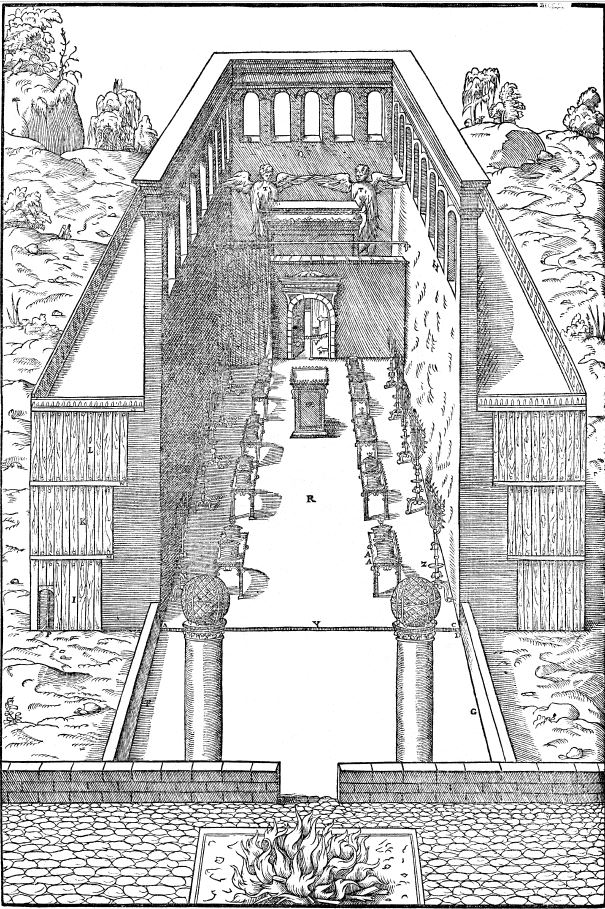
* See a drawing by Merlin, Guillaume (1538-1574) to the right is a rendering of the inner court of the temple with ritual objects. Courtesy of the Digital Image Archive, Pitts Theology Library, Candler School of Theology, Emory University: http://www.pitts.emory.edu.
>10. What were the furnishings? (4:1-22) What is the purpose of a courtyard? (9, 1 Kings 6:36; Lev. 6:16; Jer. 26:2) How long did it take Solomon to build the temple? (37-38) What is the Lord's temple now? (1 Cor. 3:16-17; and 2 Cor. 6:16)
* 2 Chronicles 4:1-10 "He made a bronze altar twenty cubits long, twenty cubits wide and ten cubits high.
2 He made the Sea of cast metal, circular in shape, measuring ten cubits from rim to rim and five cubits high. It took a line of thirty cubits to measure around it.
3 Below the rim, figures of bulls encircled it--ten to a cubit. The bulls were cast in two rows in one piece with the Sea.
4 The Sea stood on twelve bulls, three facing north, three facing west, three facing south and three facing east. The Sea rested on top of them, and their hindquarters were toward the center.
5 It was a handbreadth in thickness, and its rim was like the rim of a cup, like a lily blossom. It held three thousand baths.
6 He then made ten basins for washing and placed five on the south side and five on the north. In them the things to be used for the burnt offerings were rinsed, but the Sea was to be used by the priests for washing.
7 He made ten gold lampstands according to the specifications for them and placed them in the temple, five on the south side and five on the north.
8 He made ten tables and placed them in the temple, five on the south side and five on the north. He also made a hundred gold sprinkling bowls.
9 He made the courtyard of the priests, and the large court and the doors for the court, and overlaid the doors with bronze.
10 He placed the Sea on the south side, at the southeast corner." (1-10)
*
*
*
>11. Who was Huram? Why might the Lord God and Solomon use a man such as he? What does this tell you about how the Lord works amongst his people?
* 2 Chronicles 4:11-22 "He also made the pots and shovels and sprinkling bowls. So Huram finished the work he had undertaken for King Solomon in the temple of God:
12 the two pillars; the two bowl-shaped capitals on top of the pillars; the two sets of network decorating the two bowl-shaped capitals on top of the pillars;
13 the four hundred pomegranates for the two sets of network (two rows of pomegranates for each network, decorating the bowl-shaped capitals on top of the pillars);
14 the stands with their basins;
15 the Sea and the twelve bulls under it;
16 the pots, shovels, meat forks and all related articles. All the objects that Huram-Abi made for King Solomon for the temple of the LORD were of polished bronze.
17 The king had them cast in clay molds in the plain of the Jordan between Succoth and Zarethan.
18 All these things that Solomon made amounted to so much that the weight of the bronze was not determined.
19 Solomon also made all the furnishings that were in God's temple: the golden altar; the tables on which was the bread of the Presence;
20 the lampstands of pure gold with their lamps, to burn in front of the inner sanctuary as prescribed;
21 the gold floral work and lamps and tongs (they were solid gold);
22 the pure gold wick trimmers, sprinkling bowls, dishes and censers; and the gold doors of the temple: the inner doors to the Most Holy Place and the doors of the main hall." (11-22)
* "Huram-Abi" -Kings reports that the ancestry of Huram-Abi was through a widow of Naphtali (1 Kings 7:14). Chronicles strenthens the parallel between Huram-Abi and Oholiab by assignng him Danite ancestry. These statements are not neccissarily contradictory:
1. The mother's ancestry may have been Danite, though she lived in the territory of Naphtali.
2. Her parents may have been from Dan and Naphtali, allowing her descent to be reckoned to either. The Danites had been previously associated with the Phoenicians (Judges 18:7).
* "gold" -The extensive use of gleaming gold probably symbolized the glory of God and his heavenly temple (Rev. 21:10-11, 18, 21).
* The details of the construction of all the items used in the temple are mostly recorded in Chronicles though 1 Kings 6:14-38 and 7:13-51 mentions some of the work. Since the two books of Chronicles (two scrolls) were written sometime shortly after the Jews returned from exile in Babylon and Assyria and before the temple was rebuilt it is understandable why the Lord chose to give them this account. Much of the information was collected from other scrolls besides 1 Kings 7.
Huram-Abi is mentioned many times in chapters 2 thru 4 and 1 Kings 7. He was half Israelite since his mother was a Naphtali and his father a man of Tyre (1 Kings 7:13). He was not a Jew. He was from Tyre, and thus a Phoenician. He was sent to King Solomon to work on the temple.
The linage of the man whom God chose to construct and mold all the elegant and important bronze articles used in the temple is interesting to me. When the Jews returned from captivity they refused the let the people who were in Judah and Israel during the exile to work on the rebuilding of the temple (Ezra 4). They are called enemies of Judah and Benjamin (Ezra 4:1). Yet Solomon not only allowed others to build the first temple in Jerusalem but welcomed and needed Huram.
There is a time for everything under the sun. A person's linage is not important as his or her charactor. Often God uses the most unlikely person to do the most critical and much-needed tasks.
*
*
*
*

|























